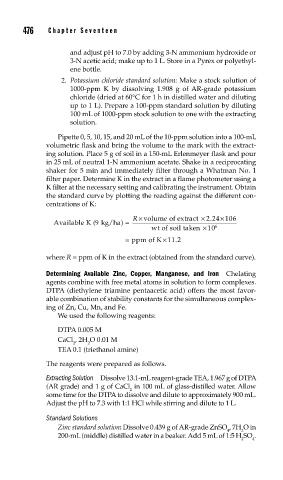Page 504 - Biosystems Engineering
P. 504
476 Cha pte r Se v e ntee n
and adjust pH to 7.0 by adding 3-N ammonium hydroxide or
3-N acetic acid; make up to 1 L. Store in a Pyrex or polyethyl-
ene bottle.
2. Potassium chloride standard solution: Make a stock solution of
1000-ppm K by dissolving 1.908 g of AR-grade potassium
chloride (dried at 60°C for 1 h in distilled water and diluting
up to 1 L). Prepare a 100-ppm standard solution by diluting
100 mL of 1000-ppm stock solution to one with the extracting
solution.
Pipette 0, 5, 10, 15, and 20 mL of the 10-ppm solution into a 100-mL
volumetric flask and bring the volume to the mark with the extract-
ing solution. Place 5 g of soil in a 150-mL Erlenmeyer flask and pour
in 25 mL of neutral 1-N ammonium acetate. Shake in a reciprocating
shaker for 5 min and immediately filter through a Whatman No. 1
filter paper. Determine K in the extract in a flame photometer using a
K filter at the necessary setting and calibrating the instrument. Obtain
the standard curve by plotting the reading against the different con-
centrations of K:
×
R × volume of extract × 2.224 106
Available K (9 kg/ha) =
wt of soil taken × 10 6
= ppm of K ×11 2.
where R = ppm of K in the extract (obtained from the standard curve).
Determining Available Zinc, Copper, Manganese, and Iron Chelating
agents combine with free metal atoms in solution to form complexes.
DTPA (diethylene triamine pentaacetic acid) offers the most favor-
able combination of stability constants for the simultaneous complex-
ing of Zn, Cu, Mn, and Fe.
We used the following reagents:
DTPA 0.005 M
CaCl , 2H O 0.01 M
2 2
TEA 0.1 (triethanol amine)
The reagents were prepared as follows.
Extracting Solution Dissolve 13.1-mL reagent-grade TEA, 1.967 g of DTPA
(AR grade) and 1 g of CaCl in 100 mL of glass-distilled water. Allow
2
some time for the DTPA to dissolve and dilute to approximately 900 mL.
Adjust the pH to 7.3 with 1:1 HCl while stirring and dilute to 1 L.
Standard Solutions
Zinc standard solution: Dissolve 0.439 g of AR-grade ZnSO , 7H O in
4 2
200-mL (middle) distilled water in a beaker. Add 5 mL of 1:5 H SO .
2 4

